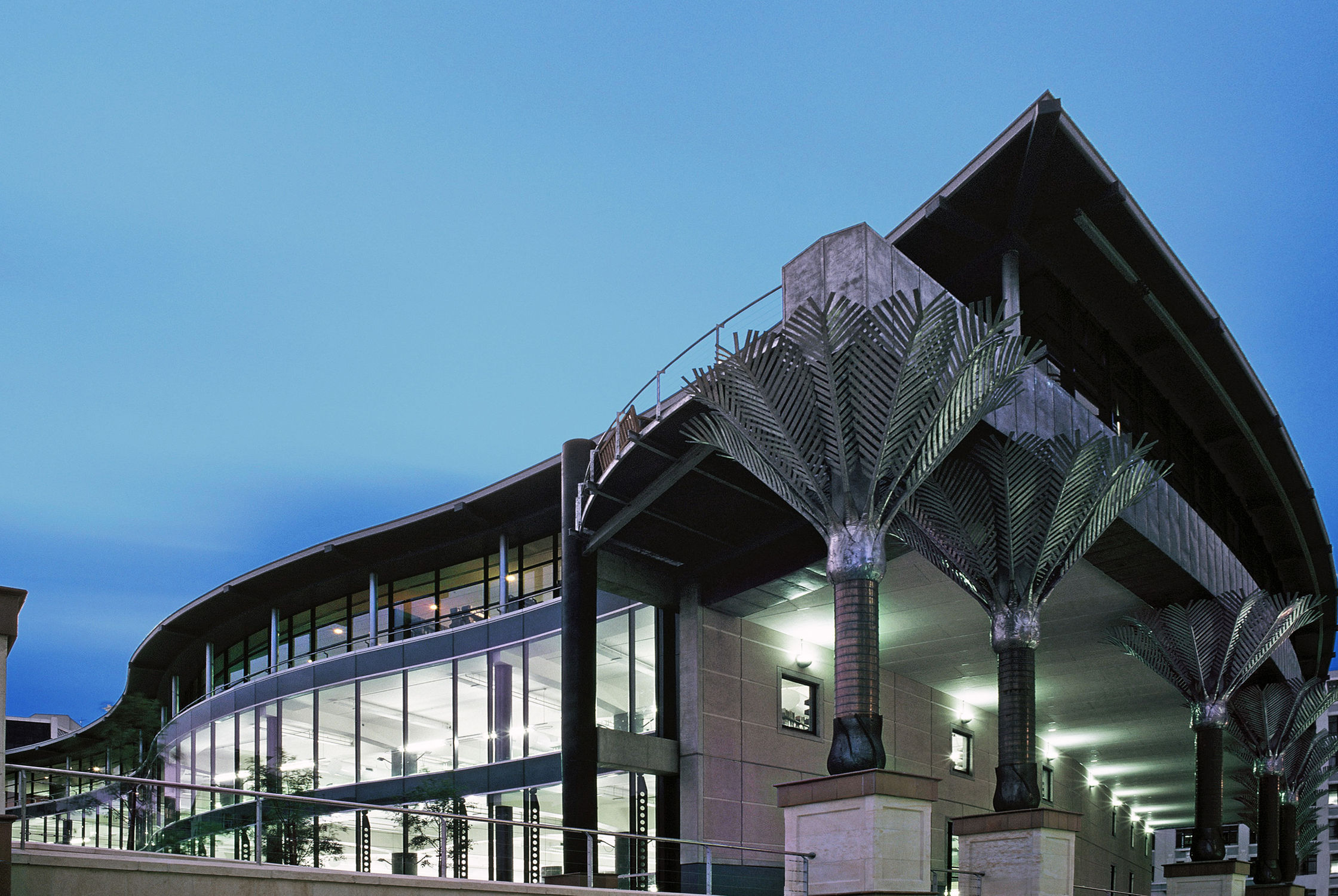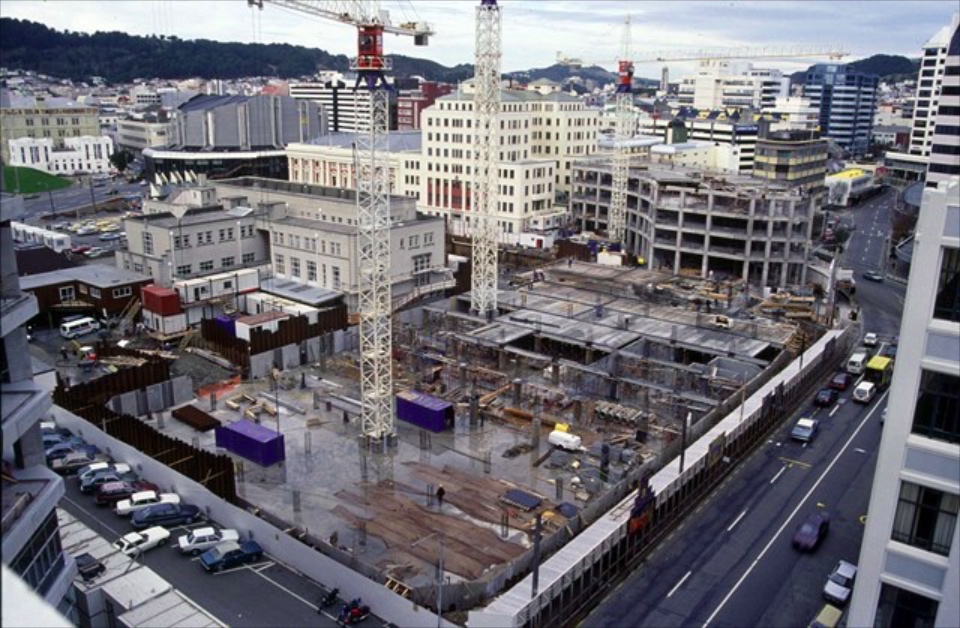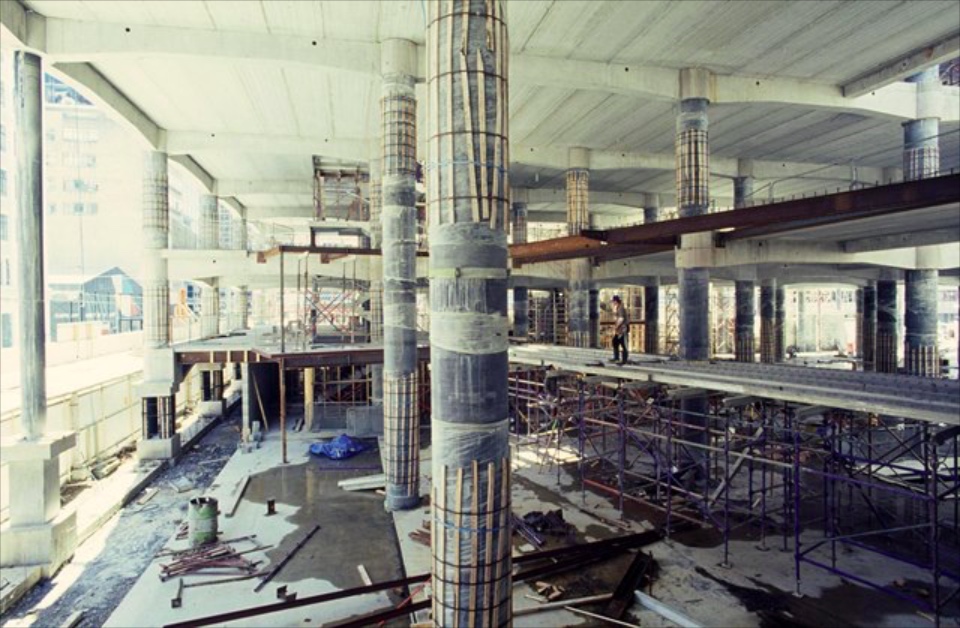I didn’t want to write a post for this, not yet, but the latest news has forced my hand: could we really be about to see the demise of the Athfield designed Wellington Central City Library ?
News headline from the DomPost today: “Wellington Central Library: ‘Knock it down and start afresh’ option with earthquake rating pending”
Mayor Justin Lester said the library’s fate was “to be determined” but part of an engineering assessment would be presented in a fortnight with a “knock it down and start afresh” a potential option.R
“Technically its earthquake rating under current code is 63 per cent but when you apply the lessons that we’ve learned from the Statistics Building it is almost 15 to 20 per cent which means it needs significant work.”
Lester said there would be options available to strengthen the building to 100 per cent, 67 per cent or 34 per cent with the final determination coming down to cost.
Rongotai MP Paul Eagle said he understood the only option available for the library building was demolition.
“Wellington City Council won’t say that because it’s politically untenable and they want to buy time to get solutions on the table.”

Hmmmmmmm……… Is this just another DomPost / Dileepa Fonseca media beat up? Or is this a real story? How can it be both at 63% and at almost 15% at the same time? The answer, my friends, is blowing in the wind – actually, no, not asbestos, but micro-cracking. Potentially. In the precast floor slabs. I reckon. Disclaimer: I have not read the engineering report and I am not an engineer. Engineers, feel free to jump in.

The following is information that has come out of the 2016 Kaikoura earthquakes. Because Kaikoura was not one earthquake, but several, and not one fault line, but several, the combined effect in Wellington was something unlike anything ever seen before in NZ, if not the world. Most earthquakes up till now have fit within the shape of a particular curve of responses, both in intensity and length of time. Usually – always, until Kaikoura – earthquakes hit with a sudden whack, and then decay away. So the curve is big at the start and then it tails off over the next 20-30 seconds, with tremors becoming more and more minor.

With Kaikoura, because it was a series of them, one after another, bang, bang, bang, bang, bang… the effect in Wellington was a quake that just went on and on and on. Things fell off walls, or fell over. 90 seconds worth. Some things that were long got a wobble on, like Rolf Harris playing the wobble-board. Horrible visual image, but true.

The effect on buildings that had been designed on the premise of a slowly decaying 30 second blast was felt especially with long-span office buildings built on reverberant land: wibble, wobble, wibble, wobble. Long building elements like precast beams supporting floor slabs flexed up and down to the extent that they started to crack a little, on the underside. Shorter building elements, like floors in old brick buildings, were not affected at all. Just the big long ones. Like Stats. Like Defense. Like Car Park buildings. Wobble wobble wobble, bounce bounce bounce, flex flex flex, crack crack crack. Perhaps understandably, putting a shit-load of heavy things, like books, on top of those floors, may make this worse. Like a fat man on a trampoline.

The problem with cracking on the underside is that it is the underside where the tension is. Any beam or suspended floor slab has tension on the lower side, holding together with steel – and steel is good in tension. So if there are cracks in the concrete, that means that the steel may have stretched. It is in no danger of collapsing, but it is a little less strong than it was, because it has stretched. So the next time there is a quake, the building is less strong. The problem is, there is little way of knowing exactly how bad that stretching is, other than by destructive testing – i.e. pulling the beam apart and seeing if the molecular structure of the steel is altered. So that may explain a little about why / how the 2 estimates may be so wildly different. And there is no way of replacing those precast slabs other than destroying the whole building to do so.

The other problem may be that the building is just so damn irregular. Stone on one facade, glass on the other. Low height quad columns on Victoria St and then tall wacky nikau palm columns on the North side. A big hole in the middle for stairs and escalators. A mezzanine floor over there, but not over here. Wavey wobbly glass lines out to sea. A user’s delight but an engineers nightmare. Most engineers hate irregular.

But the key question really is : if they do knock it down, would they ever rebuild it? Who reads books these days anyway?
Post-script: I was going to write an article on this prize fruitcake from Paraparaumu, Stuart Froude, but it turns out he is just a massive dickhead and not worth the waste of paper.





So are all concrete framed buildings at risk in the same way ?
And does the Library building have the same floor system as the Stats building? Because it keeps getting compared to that building.
JCB – no – it has affected longer span buildings more than short span buildings. That is where the public has been getting confused, understandably, as for ages they have been told that Unreinforced Masonry buildings are the highest risk, but in this case at Kaikoura, not so. The small, shorter, tight span of the URM buildings performed well agains the long, slow shake that got the wobble on with the bigger buildings. Hence, the short brick buildings didn’t react tot the resonant frequency of the shake – but buildings about 6 storeys high did. Stats? 5 floors. Defence? 6 floors. BNZ? 6 floors. Working Mens club in Cuba St (URM) 3 floors – no problems.
Stats had T-beams (probably double-Tees), while Library, as can be seen, has hollow core spans, and a LOT of book load. Actually, come to think of it, if Stats had lots of paper files, then Stats probably had a high load too. The surprising one to me is the BNZ. But, I guess, wide spans, big long precast floor beams etc. And the big fan units on the roof were removed pretty damn quickly, so their extra weight sitting up there on top of the streams, was obviously not appreciated either.
Hot off the Facebook:
“Some of you may have heard about Council’s recent consideration for the potential use of the Gallery for the Library. The team at City Gallery are happy to confirm that the Gallery will not be used in this way, instead, Council will focus on providing library services through the Manners St pop-up and two other sites in the CBD.”
> if they do knock it down, would they ever rebuild it? Who reads books these days anyway?
It was one of the busiest public buildings in the city (3000 visitors per day, according to WCC – the highest traffic of any council building, and compared with ~4000/day at Te Papa). They’d need to build something to replace it, and they might as well build a library while they’re at it.
Here’s the engineering report, by the way, in case anyone’s interested: https://wellington.govt.nz/~/media/services/community-and-culture/libraries/files/engineering-assessment.pdf?la=en
So the things that they’re worried about are loss of seating of the hollowcore floor units and web-cracking of the floor.
A slight clarification on what Lester means by both 63% and 25% is in a separate memo (I would have cut-and-pasted the relevant part, but the PDF is a scan so can’t select text): https://wellington.govt.nz/~/media/services/community-and-culture/libraries/files/engineering-assessment-memo.pdf?la=en
>Council will focus on providing library services through the Manners St pop-up and two other sites in the CBD.â€
which basically means that over 90% of the collection is going to be inaccessible for years…
Ok, Next out of box solution, invest in a miles of shelves with lockable wheels, and then use parts of the new convention centre as a “roll out” library when it is not in use for booked events, – and rolled away when the space is needed…
I’m a structural engineer. My company does lots of these assessments and repair jobs.
The concrete frames can get longer during shaking, with ductile or plastic behaviour over repeat cycles. The frames support the precast floors, and as the frames elongate this reduces the support.
When this happens, floors can drop.
We almost always have to put in steel angles or other shelf/corbel supports to be able to catch a precast floor.
If your building has precast floors with concrete frames it is probably <67%nbs if not lower. The seating is always lower than a new building and many have a "pigtail" end detail which is a real weakness which can lead to sudden loss of support.
I haven't read the report but potential reason for different numbers is new techical guidance document C5 for concrete buildings which was introduced late last year and includes ways to assess likelihood of precast floor issues.. I assume the report is to new guidelines.
Fwiw the name of the reviewer on the report (Craig Stevenson) is one of the panel of authors of the new guidance so knows what’s going on
http://www.eq-assess.org.nz/dsa-non-epb/
Greenwelly – I’m not sure that putting tonnes of books onto mobile shelves – even with a really good handbrake – is the best solution to a problem of earthquake resilience. Perhaps they should put the books into a big totalspan shed near the airport and contract Amazon to provide lots of minimum wage pixies on Segways to fetch on demand?
starkive – can’t have the Segways on the highways, so we’ll need to build some more cycleways then!
Dubpee – thank you ! Excellent feedback.
Starkive, The world has moved on From Segways, its all E-Scooters these days, maybe they could build a 50cm Hyperloop :)
50cm ? Is that the height of the tallest scooter rider? Or are users meant to go in it lengthways ?! I’m over 3 times as tall as 50cm, so I won’t fit into that standing up greenwelly…..
“Demolition on the cards but could a better Wellington library rise out of its ashes?”
https://www.stuff.co.nz/dominion-post/news/wellington/112556309/demolition-on-the-cards-but-could-a-better-wellington-library-rise-out-of-its-ashes
If demolishing Wellington’s library building is on the cards a new one should be built on the same site, an academic says. Anne Goulding believes rebuilding the library could be an opportunity for a re-think but keeping it on Civic Square would be “essential”. “Things have moved on and ideas about libraries have moved on and so the opportunity to start again might well be welcome.”
Goulding, a professor of library and information systems management at Victoria University said Wellington could look at a number of libraries, including Christchurch’s recently rebuilt one, for direction. “Libraries are more than just a storehouse of books.”
Christchurch’s library had “given people hope that their city is coming back” and there was a good mix of quiet reading spaces and technology-heavy ones…..
@ Leviathan, no it was meant as the size just for the books, the lime riders would get the books from the stack and take them to the hyperloop, :),
Although maybe we could get some Oompa-Loompas and get Lime to make up some custom scooters :) and they could use to tube to get to amd from….